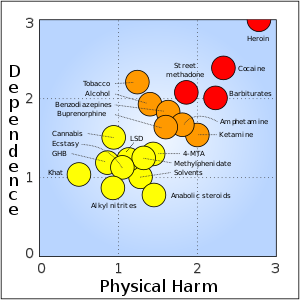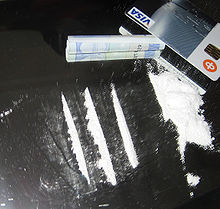
Back Middelmisbruik Afrikaans تعاطي المخدرات Arabic Abusu de sustancies AST মাদকের অপব্যবহার Bengali/Bangla Abús de substàncies Catalan Zneužívání návykových látek Czech Camddefnyddio sylweddau Welsh Droga misuzado Esperanto Abuso de sustancias Spanish Narkomaania Estonian
| Substance abuse | |
|---|---|
| Other names | Drug abuse, substance use disorder, substance misuse disorder |
 | |
| A 2007 assessment of harm from recreational drug use (mean physical harm and mean dependence liability)[1] | |
| Specialty | Psychiatry |
| Complications | Drug overdose |
| Frequency | 27 million[2][3] |
| Deaths | 1,106,000 US residents (1968–2020)[4] |

Substance abuse, also known as drug abuse, is the use of a drug in amounts or by methods that are harmful to the individual or others. It is a form of substance-related disorder. Differing definitions of drug abuse are used in public health, medical, and criminal justice contexts. In some cases, criminal or anti-social behavior occurs when the person is under the influence of a drug, and long-term personality changes in individuals may also occur.[5] In addition to possible physical, social, and psychological harm, the use of some drugs may also lead to criminal penalties, although these vary widely depending on the local jurisdiction.[6]

Drugs most often associated with this term include alcohol, amphetamines, barbiturates, benzodiazepines, cannabis, cocaine, hallucinogens, methaqualone, and opioids. The exact cause of substance abuse is not clear, but there are two predominant theories: either a genetic predisposition or a habit learned from others, which, if addiction develops, manifests itself as a chronic debilitating disease.[8]
In 2010, about 5% of adults (230 million) used an illicit substance.[2] Of these, 27 million have high-risk drug use—otherwise known as recurrent drug use—causing harm to their health, causing psychological problems, and or causing social problems that put them at risk of those dangers.[2][3] In 2015, substance use disorders resulted in 307,400 deaths, up from 165,000 deaths in 1990.[9][10] Of these, the highest numbers are from alcohol use disorders at 137,500, opioid use disorders at 122,100 deaths, amphetamine use disorders at 12,200 deaths, and cocaine use disorders at 11,100.[9]
- ^ Cite error: The named reference
Nuttwas invoked but never defined (see the help page). - ^ a b c United Nations Office on Drugs and Crime (June 2012). World Drug Report 2012 (PDF). United Nations. ISBN 978-92-1-148267-6. Archived from the original (PDF) on 7 September 2022. Retrieved 27 September 2016.
- ^ a b "World Drug Report 2014" (PDF). Drugnet Europe. No. 87. European Monitoring Centre for Drugs and Drug Addiction. July 2014. p. 4. ISSN 0873-5379. Catalogue Number TD-AA-14-003-EN-C. Archived from the original on 4 October 2018.
- ^ Data is from these saved tables from CDC Wonder at the Centers for Disease Control and Prevention, National Center for Health Statistics. The tables have totals, rates, and US populations per year. The numbers are continually updated: "This dataset has been updated since this request was saved, which could lead to differences in results." So the numbers in the table at the source may be slightly different.
- 1968–1978 data: Compressed Mortality File 1968–1978. CDC WONDER Online Database, compiled from Compressed Mortality File CMF 1968–1988, Series 20, No. 2A, 2000. Accessed at http://wonder.cdc.gov/cmf-icd8.html
- 1979–1998 data: Compressed Mortality File 1979–1998. CDC WONDER On-line Database, compiled from Compressed Mortality File CMF 1968–1988, Series 20, No. 2A, 2000 and CMF 1989-1998, Series 20, No. 2E, 2003. Accessed at http://wonder.cdc.gov/cmf-icd9.html
- 1999–2020 data: Multiple Cause of Death, 1999–2020 Results. CDC WONDER Online Database. Data are from the Multiple Cause of Death Files, 1999–2020, as compiled from data provided by the 57 vital statistics jurisdictions through the Vital Statistics Cooperative Program. Accessed at http://wonder.cdc.gov/mcd-icd10.html
- ^ Ksir, Oakley Ray; Charles (2002). Drugs, society, and human behavior (9th ed.). Boston [u.a.]: McGraw-Hill. ISBN 978-0072319637.
{{cite book}}: CS1 maint: multiple names: authors list (link) - ^ Mosby's Medical, Nursing, & Allied Health Dictionary (6th ed.). St. Louis: Mosby. 2002. pp. 552, 2109. ISBN 978-0-323-01430-4. OCLC 48535206..
- ^ Laureen Veevers (1 October 2006). "'Shared banknote' health warning to cocaine users". The Observer. Retrieved 2008-07-26.
- ^ "Addiction is a Chronic Disease". Archived from the original on 24 June 2014. Retrieved 2 July 2014.
- ^ a b GBD 2015 (8 October 2016). "Global, regional, and national life expectancy, all-cause mortality, and cause-specific mortality for 249 causes of death, 1980–2015: a systematic analysis for the Global Burden of Disease Study 2015". The Lancet. 388 (10053): 1459–1544. doi:10.1016/S0140-6736(16)31012-1. PMC 5388903. PMID 27733281.
{{cite journal}}: CS1 maint: numeric names: authors list (link) - ^ GBD 2013 (17 December 2014). "Global, regional, and national age-sex specific all-cause and cause-specific mortality for 240 causes of death, 1990–2013: a systematic analysis for the Global Burden of Disease Study 2013". The Lancet. 385 (9963): 117–71. doi:10.1016/S0140-6736(14)61682-2. PMC 4340604. PMID 25530442.
{{cite journal}}: CS1 maint: numeric names: authors list (link)